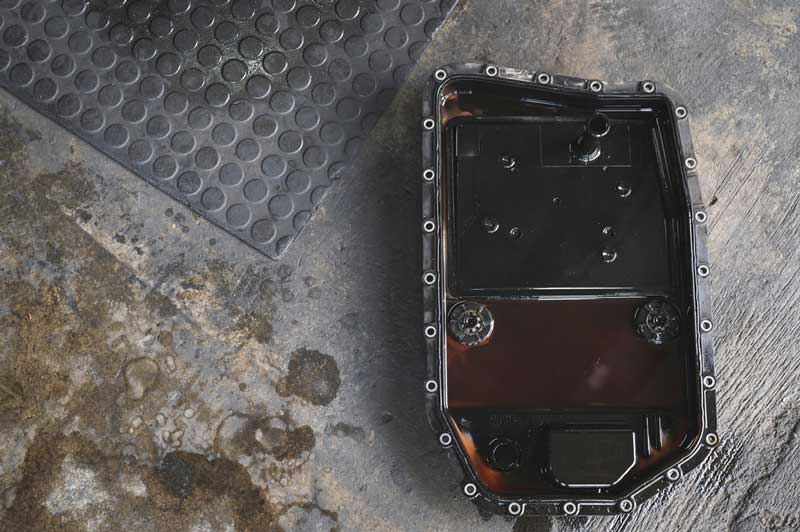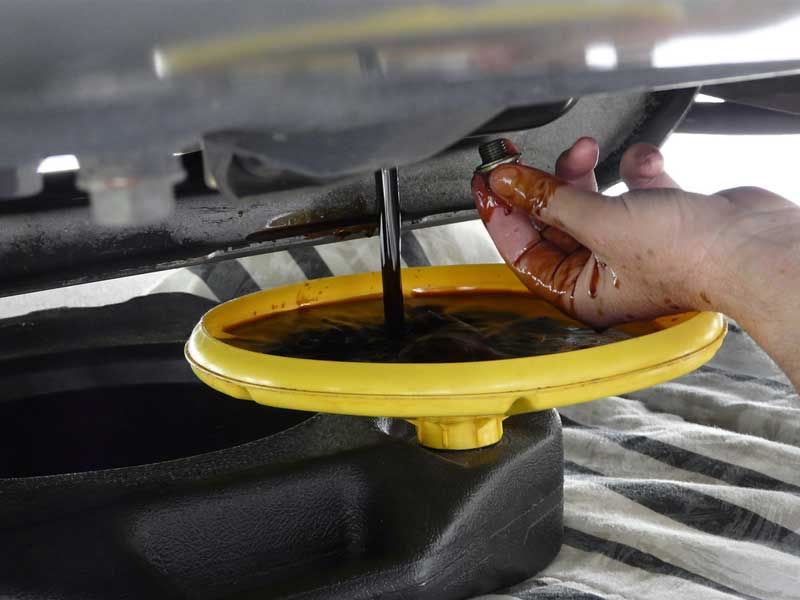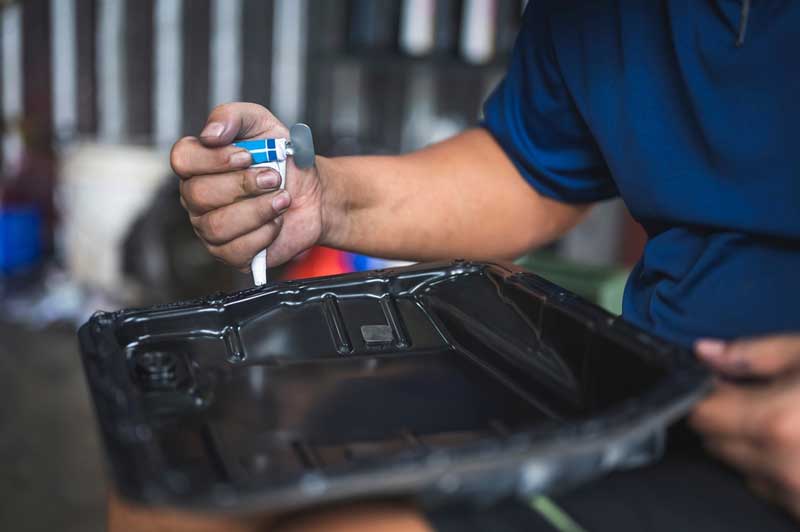How much does oil pan replacement cost? How can one tell when they need an oil pan replacement?
In this article, you get a comprehensive overview of information with regard to oil pan replacement.
The oil pan of an engine is a section that functions as a reservoir for storing oil, it also helps the circulation of oil through the engine parts.
To explain further, this guide covers the average oil pan replacement costs, factors that affect the price of oil pan replacement, signs you will need an oil pan replacement, and lots more.
Let us begin.
How Much Does an Engine Oil Pan Replacement Cost?
On average, oil pan replacement cost between $667 and $755. This includes labor cost which cost between $328 and $414 on estimate and parts which range between $339 and $341. This price range has taxes and fees excluded and does not factor in the location and the make of the vehicle. Related repairs may be required.
We will go further to discuss the factors which tend to affect the cost of oil pan replacement.
Factors that Affect The Cost of Oil Pan Replacement
The cost of an oil pan replacement can differ significantly.
This simply means that you will need to examine your car, the particular component you are replacing, and the local labor cost before you can tell the repair cost.
The following factors will affect the work price.
Cost of Labor
The most costly part of an oil pan replacement is labor. However, it is about half of the total cost.
Unfortunately, an oil pan replacement is not a clean job. The car gets to be suspended, or lifted on jacks. You can now drain the oil. Take off the oil pan.
The rate-determining how easy or difficult it is, will depend on the model and make of your car. You may take off parts often before you can completely remove the oil pan.
For instance, you may have to dismantle the car’s subframe to remove the pan in most cars. And this could take many hours.
Because of this, the cost of labor could be around 1,000 dollars. Luckily, you may only pay 250 dollars. This usually works for about two to three hours of the mechanic’s time, and shop fees.
The national mechanic’s average hourly rate is about sixty dollars, but the rates could vary from 15 to 205+ dollars.
Also Read: How to Bleed off an Overcharged AC (Expert Guide)
Cost of the Part
The price of an oil pan varies significantly. Here, the brand remains the biggest factor.
For instance, you will spend about 1,000 dollars if you purchase a new oil pan, from a BMW manufacturer. Alternatively, purchasing a new oil pan for an OEM Ford will cost about $175.
Additionally, you could always settle for made-to-fit components or aftermarket parts. These could either be produced in mass or made from different materials. However, you can get them for about 60 to 200 dollars.
Parts that are manufactured to fit many cars, or universal parts can most times cost 20 dollars.
Giving attention to fit, and materials are important. For instance, plastic is used for the production of most oil pans. And this may not be as strong as aluminum, or metal-based OEM.
However, your original pan material can be matched, because most OEM components are also produced of plastic.
Alternatively, if you are not certain about your vehicle’s lifespan, you could choose a more affordable alternative to save some cash.

Other Parts
Most times, when your oil pan gets faulty, you may have to get a replacement for other components. These components comprise the oil pan gasket, plug gasket and oil plug, and most importantly, the new oil.
However, the replacement oil pan might involve the new gaskets and plug. Meanwhile, you will have to purchase a new oil. The cost of this could be around 20 to 100 dollars, depending on the oil and brand you choose.
What Is an Engine Oil Pan?
An engine oil sump or oil pan is a reservoir attached to your vehicle’s bottom. Apart from its function of storing oil, it serves as a point that enables motor oil circulation through the engine parts.
This is how it works:
- With a pickup inlet, the oil pump carries oil from your oil pan when you ignite your car.
- Now, the oil pump starts pumping oil through the engine, cleaning, cooling your engine’s parts, and lubricating.
- The oil then circulates to the oil pan, following its designed channels.
An engine oil pan contains five essential components, for maintaining an engine that runs smoothly. They include:
Dipstick: This extends into your oil pan and carries out oil level measurements.
Drain Plug: You can find the drain plug at the engine’s bottom, under your oil pan. Its major role is to enable old oil drainage.
Oil pan gasket: A protective layer is found between the crankcase and the oil pan, and this layer is the oil pan gasket. The seal is a fluid-tight; it prevents oil leakage
Baffles: You can find this component more commonly in sports cars, than in regular cars. Its basic purpose, is the prevention of oil pan leakage, even at increased speeds.
Windage tray: This metallic plate creates an obstacle between the oil pan and the crankshaft. It impedes the over-lubrication of your crankshaft.
Why Does an Oil Pan Leak?
Just like any part in your car, your oil pan has tendencies of tear and wear, that will result in its breakdown with time. There are two main causes of pan leakage.
Faulty Gasket
Worn-out gaskets remain one basic reason for oil pan leakage. Your vehicle’s gasket has only but a specified lifespan, and because of its exposure to heat over time, it breaks down sooner. Once the degradation starts, its ability to maintain an oil-tight seal deteriorates, resulting in oil leakage.
Theoretically, your oil pan gasket is supposed to last as long as your engine. But, that is mostly not the case. The gaskets are produced from rubber, and cork could even be used for old models. Unfortunately, the cork gasket wears out quickly. They get brittle and dry; you will only see brittle flaking away. The gaskets produced with rubber could also start breaking down with time, especially due to heat exposure.
Damage
The oil pan will tend not to get damaged by the things you can see; it’s the things you are unaware of, that pose more harm to the oil pan. Because of its location under the vehicle, it is closer to the floor. Factors such as potholes and debris, tend to pose more danger to the pan.
A frustrating aspect of oil pan harm is that you may not notice it when scraping the pan in a pothole or hitting a rock. The outcome could only be a crack or hole in your pan, resulting in a slow leakage.
Four Signs You Need an Oil Pan Replacement
Some indicative signals can help in spotting when your oil pan needs a replacement. These signs include:
Oil Spots Under Your Vehicle
A pool of oil under your car can signal an oil leakage caused by an oil gasket, pan, or seal that is cracked.
Your engine parts could experience friction due to oil leakage, which can cause serious engine damage.
Therefore, if your car has an oil leakage, do well to visit an auto repair outlet and have the oil gasket and pan checked.
Sudden Drop of Oil Level
An oil gasket leakage, a leaking back main seal, or a faulty oil pan could immediately decline your oil level.
Your car will have limited oil when the oil gasket leaks, leading to severe problems, which include increased temperature, smoking engines, and whirring sounds.
There will be an illumination of the oil light on your dash if there is an irregular change in the oil level. This could signify the need to replace the oil gasket or oil pan.
An Overheated Engine
When your engine pan leaks, it could cause an engine to overheat, resulting in serious engine damage, plus a more expensive cost of repair.
The engine’s metal components will get poorly lubricated if you have low oil levels. As a result, these metal parts tend to rub against themselves, leading to engine overheating.
If your engine remains too hot for a long time, it could result in severe engine failure. Therefore, if you notice signs of an engine overheating, visit your nearest automobile repair shop.
Black Smoke Venting Out of The Engine
When your engine smokes, it should be of great concern. Smoke and burning oil are signs of oil leakage. It gets more intense if the leaking oil settles hot in the heated exhaust.
Immediately you perceive a burning oil or your engine starts smoking, you may have to stop and visit a technician.

How to Replace an Oil Pan
You could carry out an oil pan replacement, on your vehicle by yourself. However, examining if the pan can be removed without removing the subframe, will be beneficial.
At this point, a quick check can be carried out under your engine and the pan edges. If your pan is under the subframe, and cannot be removed in one way or another, you may have no choice but to take the subframe off.
If this is the case, you will need a lift instead of a jack to do the job properly.
Things you will need:
- Oil pan
- Drain pan
- A new pan gasket
- A new engine oil.
- Socket set and Ratchet
- Jacks stands, and jack
- Gasket scraper
- Cleaner for brakes
- Disposable gloves
- Sealant for the engine
- Torque wrench
- Car’s manual
Replacing Your Oil Pan
Assessing your pan is the number one step for an oil pan replacement. First, you have to examine if it operates under the subframe front. You will have to remove this.
In most cases, you may have to also remove the motor before taking the pan out. At this point, you will need to get another jack.
The motor can be removed by loosening the mounts and dropping them on a jack. Meanwhile, this could be very dangerous, and returning the motor to its original position could be difficult if you don’t take extra care.
This guideline assumes you do not have these issues.
- Your vehicle should be jacked from the rear, and you can stabilize it by placing jack stands. Most cars require jacking from both sides. If this is the case, ensure that both sides are stabilized. If both sides are not jacked, ensure the wheel on the other side is choked.
- Drain the oil. You can drain the oil using a drain pan to unscrew the plug.
- Find the pan’s mounting latch. Some pans have six to eight bolts. You must remove the subframe to access the latches if any bolts are under the frame. In this situation, you may have to re-examine your jack’s location. In addition, the frame is suspended via four bolts on both sides but directly attached to your steering rack. Dismantling this will take a longer time.
- Remove the bolts. They could be very long.
- Remove your oil pan from the mounting area.
- The mounting block should be cleaned. This may need some scraping, just in case there are remnants of an old melted gasket. Use a brake cleaner to complete the task.
- The gasket should be installed on the new pan.
- Examine where the pan goes over gaps or seams, like timing covers on the block. It should be sealed with liquid adhesive.
- Clasp the new pan to its correct position.
- The mounting nuts should be torqued, in the manner and tightness stipulated in your car’s manual.
- Refill your engine with new oil, and examine for leaks.
This process may take about two to four hours, depending on whether you have to remove the subframe or not.
If the subframe has to be removed, it will likely be just the front frame, and you will have to completely move it out to remove the bolts.
Also, if the pan mounting bolts are broken, the pieces should be removed. Then, you can make use of a magnet. Else, the new pan may have difficulties going in properly.
Finally, if you purchase a new pan plug separate from the pan, ensure it is the correct size. The quickest way of stripping a plug thread will be to use an oversized plug, which is a major reason for a pan replacement.
Watch the video below to get a view of the process of oil pan replacement.
Advantages of Getting an Oil Pan Replacement
Getting a faulty pan replacement immediately you notice it, will save you some dollars. An oil pan leakage could result in an extremely low level of oil, which leads to internal engine destruction. The cost of fixing this is higher than replacing the oil pan.
Also Read: Head Gasket Replacement Cost
Frequently Asked Questions – Oil Pan Replacement Cost
How much does it cost to replace the oil pan?
The average cost of the oil pan could be around 20 to 1000 dollars, depending on your car’s model, year, and make. Some other components that could influence its price, are the pan’s material, capacity, brand, and if it comes alongside a gasket kit or not.
Is replacing an oil pan easy?
Oil pan replacement could be difficult, and this depends on your vehicle. They are mostly attached through many bolts and, most times can be hindered by a car’s subframe or the steering components. In most vehicles, you may have to remove the frame in front of the motor before the pan can be removed.
How long does it take to change the oil pan?
Changing the pan gasket may take about 1.75 – 2.50hours, depending on your mechanic. It may take about four to six hours if you have little experience and want to change it yourself.
Can you drive a car with an oil pan leak?
You can keep driving, if you have a little valve cover or pan gasket leak, as long as you frequently check the oil level and refill when needed. Meanwhile, a leak caused by crucial engine damage, or a wounded oil pan will require towing of the vehicle.
What causes oil pan damage?
Road debris could easily damage your car’s gaskets and oil pans because they are found at the engine’s bottom. Holes could be created by rough roads, resulting in a pan leak. Your pan’s gasket suffers many tears and wear, or it could also be damaged, resulting in leaks from the gasket.
How serious is an oil pan leak?
A leaking pan gasket can be considered a moderately severe problem. This is because a severe oil leak could result in some relatively serious problems, which include subsequent engine failure.
Can a cracked oil pan Be Fixed?
A cracked pan can be fixed, depending on the crack size. You could just use some hours to complete the repair, but you may have to wait about 15 – 24 hours to drive the vehicle again.
Conclusion – Oil Pan Replacement Cost
You will likely spend about 600 to 1000 dollars, for an oil pan replacement. Replacing a faulty pan takes about two to three hours, which can be costly. However, you could also decide to carry out the replacement by yourself, which will save you some money.

